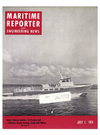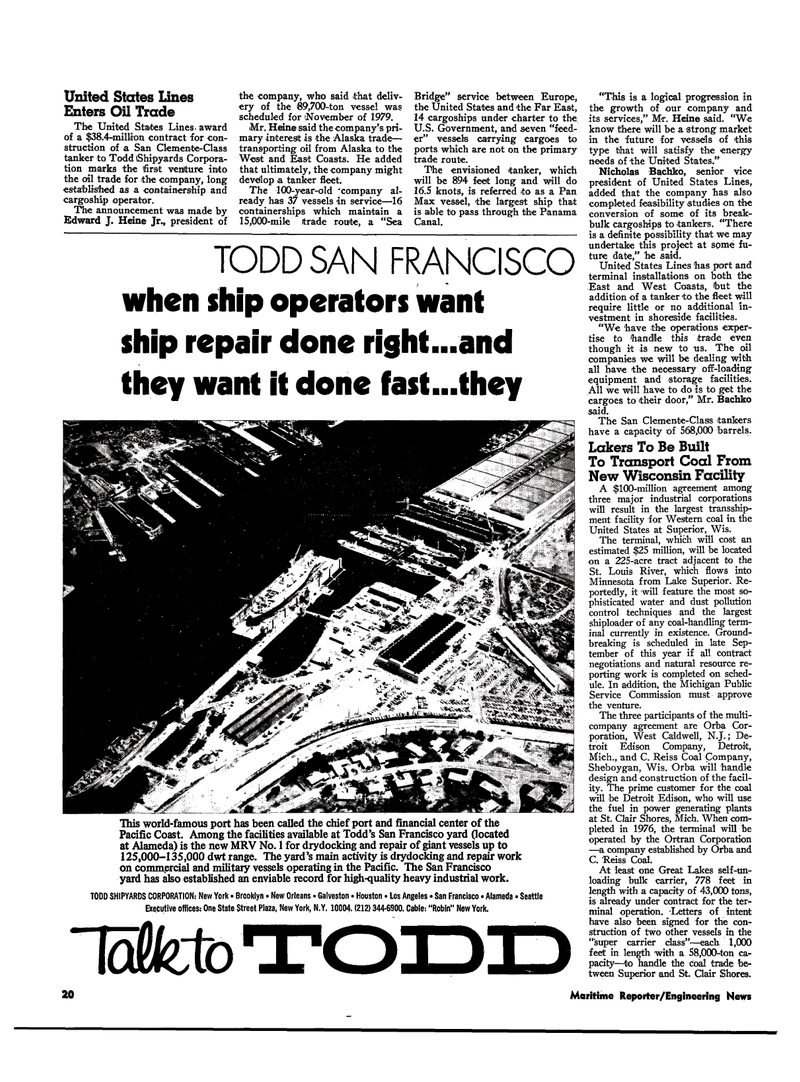
Page 14: of Maritime Reporter Magazine (July 1974)
Read this page in Pdf, Flash or Html5 edition of July 1974 Maritime Reporter Magazine
United States Lines
Enters Oil Trade
The United States Lines, award of a $38.4-million contract for con- struction of a San Clemente-Class tanker to Todd Shipyards Corpora- tion marks the first venture into the oil trade for the company, long established as a containership and cargoship operator.
The announcement was made by
Edward J. Heine Jr., president of the company, who said that deliv- ery of the 89,700-ton vessel was scheduled for ^November of 1979.
Mr. Heine said the company's pri- mary interest is the Alaska trade— transporting oil from Alaska to the
West and East Coasts. He added that ultimately, the company might develop a tanker fleet.
The 100-year-old 'company al- ready has 37 vessels in service—16 c-ontainerships which maintain a 15,000-mile (trade route, a "Sea
Bridge" service between Europe, the United States and the Far East, 14 cargoships under charter to the
U.S. Government, and seven "feed- er" vessels carrying cargoes to ports which are not on the primary trade route.
The envisioned tanker, which will be 894 feet long and will do 16.5 knots, is referred to as a Pan
Max vessel, the largest ship that is able to pass through the Panama
Canal. "This is a logical progression in the growth of our company and its services," Mr. Heine said. "We know there will be a strong market in the future for vessels of this type that will satisfy the energy needs of the United States."
Nicholas Bachko, senior vice president of United States Lines, added that the company has also completed feasibility studies on the conversion of some of its break- bulk cargoships to tankers. "There is a definite possibility that we may undertake this project at some fu- ture date," he said.
United States Lines has port and terminal installations on both the
East and West Coasts, but the addition of a tanker to the fleet will require little or no additional in- vestment in shoreside facilities. "We 'have the operations exper- tise to 'handle this trade even though it is new to us. The oil companies we will be dealing with all have the necessary off-loading equipment and storage facilities.
All we will have to do is to get the cargoes to their door," Mr. Bachko said.
The San Clemente-Class tankers have a capacity of 568,000 barrels.
Lakers To Be Built
To Transport Coal From
New Wisconsin Facility
A $100-million agreement among three major industrial corporations will result in the largest transship- ment facility for Western coal in the
United States at Superior, Wis.
The terminal, which will cost an estimated $25 million, will be located on a 225-acre tract adjacent to the
St. Louis River, which flows into
Minnesota from Lake Superior. Re- portedly, it will feature the most so- phisticated water and dust pollution control techniques and the largest shiploader of any coal-handling term- inal currently in existence. Ground- breaking is scheduled in late Sep- tember of this year if all contract negotiations and natural resource re- porting work is completed on sched- ule. In addition, the Michigan Public
Service Commission must approve the venture.
The three participants of the multi- company agreement are Orba Cor- poration, West Caldwell, N.J.; De- troit Edison Company, Detroit,
Mich., and C. Reiss Coal Company,
Sheboygan, Wis. Orba will handle design and construction of the facil- ity. The prime customer for the coal will be Detroit Edison, who will use the fuel in power generating plants at St. Clair Shores, Mich. When com- pleted in 1976, the terminal will be operated by the Ortran Corporation —a company established by Orba and
C. Reiss Coal.
At least one Great Lakes self-un- loading bulk carrier, 778 feet in length with a capacity of 43,000 tons, is already under contract for the ter- minal operation. -Letters of intent have also been signed for the con- struction of two other vessels in the "super carrier class"—each 1,000 feet in length with a 58,000-ton ca- pacity—to handle the coal trade be- tween Superior and St. Clair Shores.
TODD SAN FRANCISCO when ship operators want ship repair done right ...and they want it done fast...they
This world-famous port has been called the chief port and financial center of the
Pacific Coast. Among the facilities available at Todd's San Francisco yard (located at Alameda) is the new MRV No. 1 for drydocking and repair of giant vessels up to 125,000-135,000 dwt range. The yard's main activity is drydocking and repair work on commercial and military vessels operating in the Pacific. The San Francisco yard has also established an enviable record for high-quality heavy industrial work.
TODD SHIPYARDS CORPORATION: New York • Brooklyn • New Orleans • Galveston • Houston • Los Angeles • San Francisco • Alameda • Seattle
Executive offices: One State Street Plaza, New York, N.Y. 10004. (212) 344-6900. Cable: "Robin" New York. lofifeto TODD 10 Maritime Reporter/Engineering News

 13
13

 15
15
